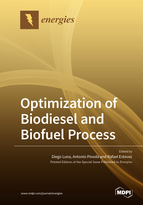Optimization of Biodiesel and Biofuel Process
A special issue of Energies (ISSN 1996-1073). This special issue belongs to the section "A4: Bio-Energy".
Deadline for manuscript submissions: closed (20 October 2020) | Viewed by 28565
Special Issue Editors
Interests: heterogeneous catalysis; green chemistry; biorefinery; renewable raw materials biotechnology; transesterification; biodiesel; biodiesel-like biofuels; eco diesel; lipases; additives; oxygenated additives
Special Issues, Collections and Topics in MDPI journals
Interests: heterogeneous catalysis; biomass valorization; flow chemistry; mechanochemistry
Special Issues, Collections and Topics in MDPI journals
Interests: heterogeneous catalysis; glycerol valorization; biofuels; bioadditives; microwave-assisted processes
Special Issues, Collections and Topics in MDPI journals
Special Issue Information
Dear Colleagues,
Although the compression ignition (C.I.) engine, invented by Rudolf Diesel, was originally intended to work with pure vegetable oils as fuel, more than a century ago it was adapted to be used with a fuel of fossil origin, obtained from oil. Therefore, there would be no technical difficulties to return to the primitive design of using biofuels of renewable origin, such as vegetable oils. The main drawback is found in the one billion C.I. engines which are currently in use, which would have to undergo a modification in the injection system in order to adapt them to the higher viscosity of vegetable oils in comparison to that of fossil fuel. Thus, the gradual incorporation of biofuels as substitutes of fossil fuels is mandatory.
This Special Issue aims to collect works that provide different technical solutions to make possible the smooth transition from the current state, in which diesel engines operate with fossil fuels, to a new situation in which diesel engines will work employing solely renewable biofuels. Thus, in addition to conventional biodiesel, obtained by catalytic or enzymatic transesterification of triglycerides, all research providing effective solutions to allow the use of fats and oils as biofuels in diesel engines, without having to perform any modification in them, will be welcomed. This Special Issue also aims to collect studies related but not limited to the production and engineering development of alternative high-quality biofuels from vegetable oils, obtained by the hydrotreating of triglycerides (green diesel), the production of novel biofuels that integrate glycerol in their composition, as well as the development of diesel and biodiesel additives. These biofuels seek to achieve 100% atom efficiency, because neither glycerol nor any byproduct is obtained. Thus, the overall production process of the biofuel is simplified to a great extent.
Prof. Dr. Diego Luna
Dr. Antonio Pineda
Dr. Rafael Estevez
Guest Editors
Manuscript Submission Information
Manuscripts should be submitted online at www.mdpi.com by registering and logging in to this website. Once you are registered, click here to go to the submission form. Manuscripts can be submitted until the deadline. All submissions that pass pre-check are peer-reviewed. Accepted papers will be published continuously in the journal (as soon as accepted) and will be listed together on the special issue website. Research articles, review articles as well as short communications are invited. For planned papers, a title and short abstract (about 100 words) can be sent to the Editorial Office for announcement on this website.
Submitted manuscripts should not have been published previously, nor be under consideration for publication elsewhere (except conference proceedings papers). All manuscripts are thoroughly refereed through a single-blind peer-review process. A guide for authors and other relevant information for submission of manuscripts is available on the Instructions for Authors page. Energies is an international peer-reviewed open access semimonthly journal published by MDPI.
Please visit the Instructions for Authors page before submitting a manuscript. The Article Processing Charge (APC) for publication in this open access journal is 2600 CHF (Swiss Francs). Submitted papers should be well formatted and use good English. Authors may use MDPI's English editing service prior to publication or during author revisions.
Keywords
- transesterification
- biodiesel
- alkaline catalysis
- acid catalysis
- hydrotreating of triglycerides
- green diesel
- biodiesel-like biofuels
- Gliperol
- DMC-BioD
- EcoDiesel
- lipases
- additives








